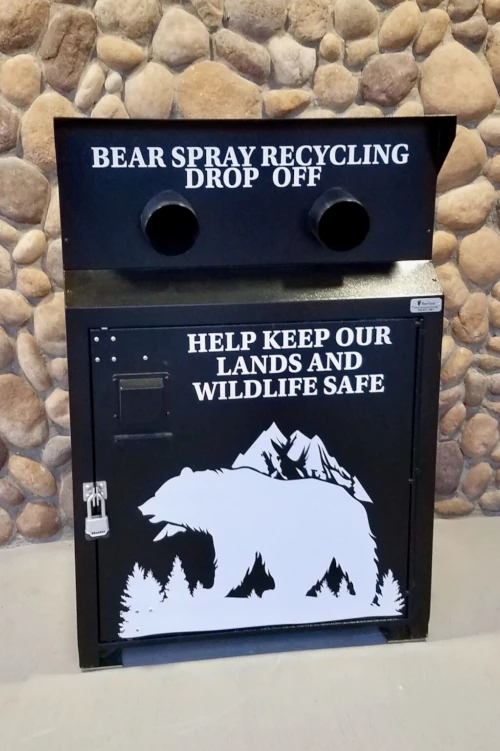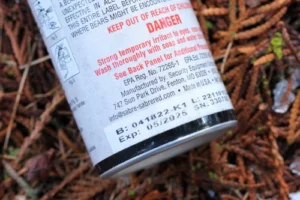
By Laura Roady
Naturally North Idaho
 Do you have expired bear spray sitting around? Not sure how to dispose of bear spray properly? Boundary and Bonner County residents and visitors now have an easy method for disposing of bear spray properly. The Kootenai Tribe of Idaho Wildlife Department has spearheaded a program for bear spray recycling to keep bear spray canisters out of landfills and to recycle the canisters.
Do you have expired bear spray sitting around? Not sure how to dispose of bear spray properly? Boundary and Bonner County residents and visitors now have an easy method for disposing of bear spray properly. The Kootenai Tribe of Idaho Wildlife Department has spearheaded a program for bear spray recycling to keep bear spray canisters out of landfills and to recycle the canisters.
“The main goal is to have an area to dispose of bear spray properly,” says Shelby Therrian, Kootenai Tribe of Idaho Wildlife Ecologist/Wildlife Division Manager.
In Boundary County, the big black box with a white bear on the front is located at the Sturgeon Station on Highway 95, just south of Three-Mile Junction.
By early June, a recycling box will be located at the Sandpoint Ranger District office in Bonner County.

For Kootenai County residents, the Kootenai Tribe of Idaho is working with Idaho Fish and Game to install a recycling box in Coeur d’Alene, according to Therrian.
Outside of North Idaho, other agencies, groups and businesses have established bear spray recycling programs in the Greater Yellowstone area and Glacier National Park area. Since bear spray cannot be taken on airplanes, many airports in Montana and Wyoming’s grizzly bear country have drop-off boxes for bear spray recycling.
Any bear spray canister is accepted, whether expired, partially used or inert training canisters. The recycling boxes are drop-off points for residents, visitors, and employees of any business or agency utilizing bear spray.
Thousands of visitors and residents in Boundary and Bonner County buy bear spray when recreating in bear country and the hope is never having to discharge the bear spray, says Therrian.
Tossing the expired bear spray into the trash creates environmental hazards in landfills from the harsh irritants and chemical propellants, according to Therrian.
Additionally, the bear spray is a safety concern for landfill workers who drive over the garbage with large machines. The weight of the machines can pop off the tops of bear spray, sending fumes everywhere. Garbage isn’t handled gently either, like when you carry bear spray, so being transferred between collection points, garbage trucks, dumpsters and the main landfill provides many opportunities for the top to pop off or the canister to be punctured.
Disposing of bear spray properly and recycling bear spray canisters increases landfill worker safety, reduces waste, reuses ingredients and recycles aluminum, according to the Interagency Grizzly Bear Committee.
Student research at Montana State University led to the development of a facility to recycle bear spray canisters according to the Interagency Grizzly Bear Committee.
For recycling, bear spray canisters are punctured to empty the contents. The extracted spray is filtered and the pepper ingredients are added to paint which is applied to the bottom of boats to repel barnacles.
The plastic top is removed and sent to plastic recycling. The aluminum can is flattened and recycled for high-grade aluminum.
Currently only a handful of recycling centers can safely process bear spray canisters, says Therrian. The bear spray canisters collected here will be brought to a sorting facility in Washington by the Kootenai Tribe of Idaho Wildlife Department.

Does expired bear spray still work? Well, it depends. A test done by CBC Yukon found that expired bear spray ranges from working effectively to not spraying as far to just oozing out of the canister.
Bear spray contains capsaicin (a chili pepper extract), a propellant and a carrier agent. The capsaicin stays potent even when expired. The carrier agent keeps the capsaicin dispersed throughout the spray and doesn’t affect expiration.
The expiration date is added for the propellant because the canister is under pressure and the pressure could decrease over time according to Counter Assault, a bear spray manufacturer. Therefore, as propellent leaks out, the capability to spray as far decreases.
Manufacturers add an expiration date on the canister for maximum effectiveness, according to Counter Assault—which for Counter Assault bear spray is four years.
“To keep promoting the positive use of bear spray, we need to provide people a way to properly dispose of their bear spray,” says Therrain. The Kootenai Tribe of Idaho Wildlife Department’s bear spray recycling program is aimed to keep the environment, wildlife and people safe.
Laura Roady loves the outdoors, and she started sharing her discoveries in 2009 when she began writing an outdoor column for the Bonners Ferry Herald. Since her first column on turtles, she’s written over 250 columns and has also written articles in Montana Outdoors, Backwoods Home magazine, BackHome magazine, The River Journal and Sandpoint Magazine. She graduated from the University of Alaska Anchorage with a Bachelor of Science in Natural Sciences, with an emphasis in geology and biology. When not exploring the back country and the wild places together, she, her husband and two children make their home in Bonners Ferry.
